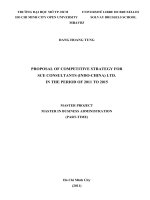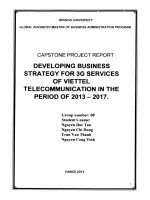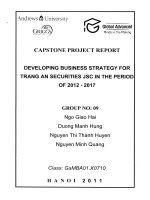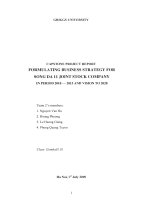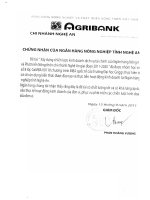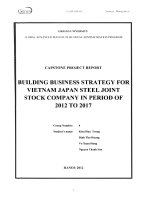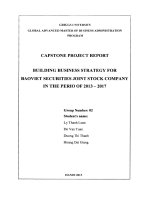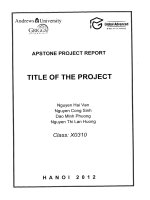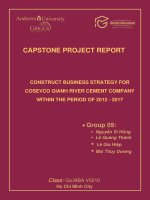Construct business strategy for cosevco Gianh river cement compan within the period of 2012 - 2017
Bạn đang xem bản rút gọn của tài liệu. Xem và tải ngay bản đầy đủ của tài liệu tại đây (2.05 MB, 123 trang )
CONSTRUCT BUSINESS STRATEGY FOR
COSEVCO GIANH RIVER CEMENT COMPANY
WITHIN THE PERIOD OF 2012 - 2017
CAPSTONE PROJECT REPORT
Ho Chi Minh City
Group 09:
Nguyễn Sĩ Hồng
Lê Quang Thành
Lê Gia Hiệp
Mai Thủy Dương
Class: Ga.MBA V0210
1
OPENING
1. The necessary of the research topic
In the context of the crisis of the world economy and the domestic economic
difficulties, the State's public investment was cut, the market price is unstable, and
the freeze real estate market has great effect to enterprises which producing
construction materials, including cement
Vietnam Cement Association also concedes: first 6 months in 2012, clinker
production reached 25.5 million tons; cement is approximately 24.3 million tons
which decreased approximately 10% compared to the same period in 2011. Domestic
cement consumption reached 23.6 million tons, down about 10% compared to the
same period in 2011. However, the cement industry is faced with a paradox: the
production and consumption reduce, but the production capacity of the industry
increases.
Therefore, to overcome this difficult period, the cement business must analyze their
own situation, to find the strengths, weaknesses, and opportunities to take advantage
of and promote the available resources, from which building business strategies
consistent with the characteristics of each enterprise in order to survive and develop
in the competition, overcome difficulties.
As an enterprise that has just established and went into operation in August, 2006, the
Cosevco Song Gianh Cement Company gradually assert them in the cement
manufacturing sector. However, in this context, the company faced many difficulties
in production and business activities. To make good use of the current opportunities
as well as the prevention of threats, the company need to operate based on a right
strategy in accordance with the changes of the business environment. On that basis,
our group selects the topic "Building business strategy of Cosevco Song Danh
Cement Company for the period 2012 – 2017”.
2
2. Research objectives
Purpose of the study is to analyze and evaluate the operation state, from which to
build business strategies for Cosevco Song Gianh Cement Company for the period
2012 - 2017, and propose solutions to implement this strategy in order to sustainably
maintain and develop, stabilize business activities of the Company.
The study used the accurate and objective data from reliable data sources that are
Cosevco Song Gianh Cement Company, Vietnam Cement Association, along with
the analysis and evaluation of a real and objective problem, consistent with the
practice as well as the general trend of the society, therefore, the applicability is very
high.
3. The object and scope of the study
- Object: The study object is the problem of strategy building, from that, applying in
business operation analysis and development direction determination for Cosevco
Song Gianh Cement Company in the future
- Scope: focusing on the factors of cement business production of the company
through collected data in three years 2009, 2010, 2011 and the first six months of
2012
4. Research Methodology
4.1- Data collection and processing method: Collecting information through the
business production result report, resources situation report, document about
distributors, customers, partners of the Cosevco Song Gianh Cement Company, the
information in the newspaper, Website, etc.; collecting data via surveys, interviews
with experts, leaders
4.2- Analysis methods
- Comparison methods: comparing business activities of the Company with the
business results of the competitor.
- Inductive method: Identify from small problems, more general conclusion for the
problem to be analyzed
- Matrix analysis method
3
SWOT matrix, the external factors evaluation matrix (EFE), the internal factors
evaluation matrix (IFE), the IE matrix, QSPM matrix will be used in the strategy
building process
4
CONTENTS
CHAPTER I: BASIC ISSUES IN BUILDING BUSINESS STRATEGIES
1. Business strategy of the enterprise
1.1. The concepts of business strategy
There are so many different views and approaches when mentioning business
strategy
Business strategy is the art
Alain Threlart said that: "Strategy is the art which the enterprise used to front
competition and to gain success."
M.Porter said that: "Strategy is the art of building solid competitive advantage to
defend."
In view of management category, business strategy is a form of planning
G.Arlleret said that: "The strategy is to determine the ways and means to reach the
defined objectives through the policies."
Gluecl said that: "Strategy is a series of plans with the nature of consistent,
comprehensive and aggregation that is designed to ensure the objectives of the
enterprise will be implemented"
According to the view of unification combination that:
Chandle considered: "Strategy includes the determination of the basic and long-term
goals of the enterprise, and apply a sequence of actions as well as the allocation of
necessary resources to perform these goals”.
According to Johnson & Schole: "Strategy is the direction and scope of an
organization in the long term to gain a competitive advantage for the organization
through the format of its resources in a changing environment, to meet the needs of
the market and satisfy the expectations of related parties. "
In summary, business strategy has basic features as follows:
- Business strategy clearly identifies the basic objectives and business direction of the
enterprise in each period.
5
- The orientation of the strategy is to ensure continuous and stable business
development in a constantly fluctuating business environment.
- Business strategy ensures maximum capital mobilization and optimally combines
the exploitation and using the resources of the enterprise in current and in the future,
promoting the advantages and catches the opportunities to gain the advantage in the
competition.
- Business strategy of the business is reflected throughout the process continuously
- Strategic business always has thinking of progress, to gain success in business
market.
- Business strategy is often built in the long term (3, 5, 10 years)
1.2 The role of the business strategy:
- Business strategy helps enterprises to identify the purpose, its direction as a basis,
the guideline for all business activities of the enterprise
- Business strategy helps the enterprise to understand and take advantage of business
opportunities, and having proactive measures to overcome the risks and threats in the
competition market.
- Business strategy makes contribution in improving the using efficiency of
resources; enhancing the competitive position of the enterprise to ensure the
sustainable development of the enterprise.
- Business strategy creates a solid basis for proposing of business production policies
and decisions consistent with the fluctuations of the market
1.3 Types of business strategy:
1.3.1 Concentrated Growth Strategy
Growth strategy is driven solutions having the ability to help enterprises increase
sales and profitability of the business unit that is higher or equal to the average
growth rate of the industry.
This strategy is associated with rapid or stable growth target depending on the
environment characteristics of each business industry, the growth can be achieved in
a number of different strategies. This type has three main strategies:
6
1.3.1.1. Market penetration
Market penetration is strategy that enterprise uses existing products to find ways to
increase the current market share through marketing efforts. Market penetration
strategy can be used as a single strategy or a combination of different strategies
Nature of market penetration strategy is that the enterprise focuses on developing
business in depth. The enterprise well developed existing markets, increasing
advertising costs, the number of sellers, offers the name of goods, increasing public
relations
The goal to achieve is to increase new customers, the quantity of goods and services
that are purchased by customers, maintain the existing customers, developing the
reputation with customers, making the company's position increasing.
1.3.1.2. Market Development
Market Development is the strategy that tries to sell existing products in new
markets.
According to this strategy, enterprises needs to strive to find new markets to sell the
existing products with solutions: Searching the market on new areas including
territories and other countries; Searching new target customers even in the current
market; Find out the new use value of the current product
Achieved purposes may both have created a new market for the company, and has
helped the company to extend the product life cycle and increase sales and profits for
the company
1.3.1.3 Product Development
Product Development is product development strategy that has just consumed in the
company's current market. New products can be selected according to this strategy is
products that has just improved.
New product development methods are mainly as following:
- Development of a separate product can be done through the path: Change of
product features; quality improvement; product designs improvement.
7
The goal is to increase the reliability, speed, durability and other characteristics of the
product that are producing, simultaneously changing the shape and form of products
such as structural changes, the color, cover create product differentiation
- Develop product portfolio: product portfolio development can be done through the
addition of new items or improving producing products, such as:
Adding product designs with features, effects, characteristic of inferior quality;
Additional product design are higher features, effects, quality, or add both the
product design features, and effects with lower quality than current products
The purpose is to create new models of products, besides the company can prevent
the penetration of the enterprises that want to provide for the market the product with
the different design, features and quality. Meeting the needs of all customer groups
that require quality products with different prices
1.3.2. Basic competitive strategy
1.3.2.1. Cost leadership strategy
Cost leadership strategy is a strategy which the enterprises intend to become low-cost
producers in the industry.
Cost leadership strategy is all actions to provide the product or service with
characteristics accepted by the customer with the lowest cost in relation to all the
competitors.
The purpose of the person who pursuing cost leadership strategy is better than the
competitors, so that the cost to produce and supply any products or services that it
can do lower than competitors, creating the barriers to entry for competitors, while
creating loyalty and avoid discount demanding of the customer
1.3.2.2. Product differentiation strategy:
In this strategy, enterprises find opportunities to become "the unique" in the industry,
according to general acknowledgement, of the buyers under certain aspects. The
strategy chooses one or several attributes of the products that the buyer assesses
importance level and positioning itself as the only person who can meet that need.
And separate price will be commensurate with this unique. Increased rates of person
creases differentiation that higher than the price that the direct costs required, and
8
customers are willing to pay for it because they believe in the product differentiation
quality is valuable distinction.
The objective of this strategy is to make a difference is to gain competitive advantage
in the market.
1.3.2.3. Concentrated strategy
Concentrated strategy is the third general competitive strategy. The main difference
with the two strategies is that it directs to serve the needs of the customer group or
limited customer segment. A Concentrated strategy will focus on specific market gap
that can be defined in terms of geography, customer type, or by segments of the
product line. Person who applies this strategy selects a segment or group of segments
and adjust it’s strategies to serve this segment, without regard to other objectives
1.3.3 Integrated Strategy
1.3.3.1. Horizontal integration strategy:
This strategy is basically working with enterprises in the business industry to create a
favorable environment of the industry, reducing losses due to competition and gain
potential profit.
1.3.3.2. The rear vertical integration strategy
This strategy is the cooperation among partners for the supply of input, output
product consumption to maintain, control the stability of resources, cost and business
environment to support the other strategy for effective enforcement.
2. Strategy building process
Overall business strategy is outlined based on the vision statement of the enterprise,
oriented for the entire operation of the enterprise and therefore it has the nature of the
long-term strategy.
Building business strategy is the first stage in the process of strategic management.
Strategy building process consists of five steps, as follows:
9
2.1. Defining the strategic vision, mission and objectives
Strategic vision refers to the future business direction of the Company, "Where will
we go?"
- The market should be pursued
- The concentration in the future is technology, products and customers.
- Type of management Board Company is trying to be created
The mission statement of most companies focuses on current business activities “who
we are and what we do?"
- The current products and services
- Customer demand is being served
- The business and technology capacity
This message represents the core values of the enterprise. It expresses the important
things, contributions of the enterprise in terms of business and life; it says the motto
of the enterprise, the location of that enterprise and the things that enterprise
committed to compliance.
A strategy should begin by identifying the expected results that the business strategy
is established to implement them. The strategic targets will play a role in operating of
the business for a number of years
It is necessary to distinguish between strategic objectives and mission, the vision of
the enterprise. In fact, many enterprises tend to confuse objectives with the mission
of the enterprise. The mission of the enterprise indicates the purpose or reason for
existence of the enterprise, thus, it often has nature of high generalization. In
contrast, strategic objectives need to be specifically ensured, quantified and having
clear deadline.
The selection of goals has a large impact on the enterprise. An enterprise that selects
high profit is a strategic objective will focus on serving the customer groups or
market segments high profits by offering high value-added or cost performance fees
in excess of dominant. In contrast, the growth target selection can lead enterprise to
diversify the product line to attract customers in different market segments
10
2.2. Analysis of the external environment
The operation environment research of the enterprise focuses on identifying and
evaluating trends and events exceed the control ability of a Company. Operation
environment of the enterprise is divided into two categories: macro-environment and
industrial environment
2.2.1 Macro environment
Using PEST model to analyze the micro environment, this is the factors that affect
directly to the economic sectors, these elements are external factors of the enterprise
and industry, thus, the industry must be suffered its effects as part of objective
factors.
- The economic factor: the main effects on economy include: inflation rate, banking
interest, the period of the economic cycle, the balance of payments, fiscal and
monetary policy
- Socio-cultural factors: culture and society impact enterprise mainly in the
following aspects: population, intellectual standard, customs, practices and views on
living standards, ethical standards, business community and women workers,
changing consuming habits, etc. Social factors often change slowly so it is difficult to
identify.
- Legal, government and politics factor: the influence of factors of law,
government and polity is larger and larger to activities of the enterprise. Enterprise
must comply with the regulations of the Labor Code, loans, safety, pricing,
advertising; rules on competition; tax laws, etc. as well as political stability of the
country.
- Technological factors: technological factors have a huge impact on enterprise as:
new technology detection, the technology transfer speed, technology products market
etc. When many advanced technologies were established, it will create opportunities
and risks for all industries and enterprise.
- The natural factor: Nature has main effects such as: environmental pollution, the
influence of geographical conditions, lack of energy, and waste of natural resources
with growing demand for limited resources
11
2.2.2 Industrial environment
Industry is a group of companies providing products or services that can be
substituted closely together. Rigorously replacement means that the products or
services meet the customer needs are basically the same. The industry is very
different in economic characteristics, the competitive situations and profit collection
prospects in future
To analyze the industrial environment of the enterprise, we applied the five force
model of Michael E.Porter (1980) shown in the following diagram:
Figure 1: five force model of Michael E.Porter
12
Finger 1: 5 force model of Michael E.Porter
- Potential competitors: This force includes the companies that are not competitive
in the industry, but they are able to do it if they want. Identifying new competitors
may enter the industry is an important thing because they can be factors that reduce
the profits of the company because they put in new production capacity, with the
desire to gain market share and the necessary resources
- The competitors in the industry: the second force in the five competitive forces
model of Porter is the degree of competition between companies within an industry.
Because enterprises in an industry are mutual dependence, the actions of a company
usually associated with the actions of the other company's response. The rivalry is
intense when an enterprise is challenged by the actions of other enterprises or the
enterprises are aware of an opportunity to improve its position in the market
- The buyer: Customer's credibility is the most valuable asset of the company.
However, the dominant buyer can make profit of industry dropped by price squeeze
or require higher quality and provide more services.
Potential
Competitor
s
Competitors in industry
Competition among
current enterprises in the
industry
Buyer
Suppliers
Substitute
products
Risk from new
competitors
Negotiation
ability of
buyer
Threats from
substitute products
and services
Negotiation
ability of
supplier
13
- The supplier: The supplier includes the following subjects: providing materials,
finance and labor. Supplier has the advantage, they can exert tremendous pressure
and create disadvantages for enterprise as they push price rising or reduce input
quality requirements that they provide to the company.
- Substitute products are products of the industries that serve customer needs
similar as to the analyzing industries, substitute products limits industry's profit
potential by control the highest price rates for companies in the industry. The
existence of close substitute products represents a competitive threat
As a result, the analysis of external environmental factors will allow enterprises to
clearly identify what are the opportunities that enterprises can take advantage of, and
what are the challenges that enterprises must face. Assess opportunities and
challenges from the external environment allows enterprises to build clear business
tasks and setting reasonable policies to achieve the goal
2.3. Analysis of the internal situation of the enterprise
To survive and develop, all organizations must carry out activities related to human
resources, technical infrastructure, technology, finance, marketing and organizational
structure. In each field of activity, each organization has its strengths and
weaknesses.
Analysis and evaluation of internal environmental factors allows identifying the
strengths and weaknesses of the enterprise. Factor brings strengths for the enterprise
if it offers a competitive advantage for the enterprise (the fields that enterprise has
potential to perform is better than existing and potential competitors)
Analysis of the internal environment is an important part of strategic management. If
not good analysis of the internal environment, not right reorganization of the
strengths and weaknesses of the organization will not be able to set up the perfect
strategy. Conversely, if good analysis of the strengths and weaknesses, it will allow
determining the future goals and strategic direction of the enterprise.
2.4. Developing strategic plans
On the basis of the results of external and internal environment analysis and
evaluation, identifying opportunities and threats, strengths and weaknesses of the
14
companies will build the right and suitable strategic methods, match between the
resources and the ability of the company to the needs and characteristics of the
environment in which the company is active.
2.5. Analysis of strategic selection
The Company must evaluate several options corresponding ability that can achieve
the main goal. The created strategic plan can be at different levels, allow existing in
the best way, best suited to the rapidly changing of environment. As a result, in the
business process, enterprises must always identify its short-term and long-term goals.
Business strategy is the way to reach the goal.
2.6. The strategic selections and analysis techniques
2.6.1. External factor evaluation matrix (EFE)
This matrix helps us to summarize and quantify the effects of environmental factors
to the enterprise. Development of an EFE matrix consists of five steps:
- Make a list of the factors that play a decisive role in the success as identified in the
macro environmental assessment process (between 10 and 20 factors)
- Classify importance level from 0.0 (not important) to 1.0 (very important) for each
factor. This classification shows the importance level of the factors for the success of
the company's business. Total of classification level must be equal to 1.0.
- Classify from 1 to 4 for each determinant of success. In which: 4 is a good
response, 3 is above average, 2 is medium and 1 is weak.
- Multiply the importance level of each variable to its classification (= steps 2 x step
3) to determine the importance score.
- Add the total scores of importance for each variable to determine the total
importance score for the organization.
Regardless of the number of opportunities and threats in the matrix, the highest total
importance score that a company can have is 4.0; the lowest is 1, 0 and average is
2.5.
15
No.
Main external factors
Weight
Assessment
score
Total score
1
2
…
TOTAL
1,0
2.6.2. Internal Factor Evaluation (IFE)
This matrix has functions of summarizing and evaluating the important strengths and
weaknesses of function business department. IFE matrix is developed in five steps:
- Making a list of the factors are the key strengths and weaknesses (between 10 and
20 factors).
- Classify importance level from 0.0 (not important) to 1.0 (very important) for each
factor. Total importance level must be equal 1.0.
- Classify from 1 to 4 for each of the factor, including: 1 represents the largest
weakness, 2 is the smallest weaknesses, 3 is smallest strengths, and 4 is the largest
strengths.
- Multiply the importance level of each factor with its classification (= steps 2 x step
3) to determine importance score.
- Add the total scores of importance for each factor to determine the total importance
score for the organization.
Total highest score is 4.0; the lowest is 1.0; the average is 2.5. Total score is larger
than 2.5 indicates the company is strong in internal, score is less than 2.5 shows the
company is weak in internal.
16
No.
Main external factors
Weight
Assessment
score
Total score
1
2
…
TOTAL
1,0
2.6.3. Competitive profile matrix
This matrix helps the company to identify key competitors, along with their
advantages and disadvantages; the way to build competitive profile matrix similar to
the way building External factor evaluation matrix.
Evaluation
factors
Weight
Enterprise
Competitor 1
Competitor 2
Evaluation
score
Total
score
Evaluation
score
Total
score
Evaluation
score
Total
score
Total
1,0
….
….
….
Comparing the total scores of the Company with major competitors in the industry to
evaluate the competitiveness of the company, through that, identifying competitive
advantages and weaknesses need to be overcome
2.6.4. SOWT matrix
SWOT analysis is a useful tool for understanding and decision-making in any
situation for any business organization. Stands for 4 words Strengths, Weaknesses,
Opportunities and Threats, SWOT analysis provides a strategy analysis tool, review
and evaluates the position and orientation of a company or of a business plan.
17
SWOT MATRIX
STRENGTHS - S
1.
2. Listing strengths
3.
4.
WEAKNESS - W
1.
2. Listing weakness
3.
4.
OPPORTUNITIES - O
1.
2. Listing opportunities
3.
4.
SO STRATEGY
1.
2. Using strengths to take
advantage of opportunities
4.
WO STRATEGY
1.
2. Overcome weakness by
taking advantages of
opportunities
THREATS - T
1.
2. Listing threats
3.
4.
ST STRATEGY
1.
2. Using strengths to avoid
threats
4.
WT STRATEGY
1.
2. Minimize weakness and
avoid threats
2.6.5. Internal and external factor evaluation matrix
IE Matrix set the different SBU of an enterprise on 01 state with 09 cells. This matrix
is based on two key aspects:
- Total importance scores of the IFE matrix represented on the X axis
- Total importance scores of the EFE matrix represented on the Y axis
2.6.6. QSPM Matrix
According Fred R.David, QSPM matrix uses input information from the IFE matrix,
EFE matrix, competitive profile matrix, SWOT matrix to evaluate objectively the
best alternative strategies. Six Steps of development of a QSPM matrix:
- Lists external important opportunities / threats and internal strengths /
weaknesses of the company
- Classify each internal and external important success factor. This classification is
the same as in the IFE matrix and EFE matrix.
18
- Identify substitute strategies that the company should consider to implement.
Combine strategies into separate groups if possible
- Determine attraction scores of each strategy (AS). Attraction scores are divided
as follows: No.1 is not attractive, No. 2 is somewhat attractive, No. 3 is quite
attractive and No. 4 is very attractive. If success factors do not affect the selection of
strategy do not score attraction for strategies in this strategic group
- Calculating total attraction score (TAS) is the result of multiplying classification
scores (step 2) with attraction score (step 4) in each row.
- Calculating total attraction score for each strategy. It is the addition of total
attraction score in the strategy column. The higher scores indicates the more
attractive strategies
19
CHAPTER II: ANALYSIS OF INTERNAL AND BUSINESS ENVIRONMENT OF
THE COMPANY
1. Introduction about the Company
1.1. Development history of the Company
COSEVCO Song Gianh Cement Company is accounting enterprise depending on
JSC Mien Trung Corporation
Address: Tien Hoa Communist - Tuyen Hoa District, Quang Binh Province.
COSEVCO Song Gianh Cement Company was established on the basis of the
COSEVCO Song Gianh Cement firm approved the construction by the Prime
Minister in accordance with Decision No. 509/QD-TTg dated 24.04.2001 issued by
Mien Trung Corporation (current is a Mien Trung corporation joint-stock Company)
as an investor with a capacity of 1.4 million tones / year with a total investment of
more than 3200 billion with the most modern technology equipment line in the world
provide by the Polysius firm of the German Federal.
On 04/06/2006 Factory started trial production of first clinker, then try the
manufacture of cement
To manage and put into production, on 06.25.2005 the Board of Directors of the
Central Construction Corporation issued Decision No. 234/QD-TCT-HDQT, founded
COSEVCO Song Gianh Cement Company under the Corporation. In August / 2006,
the Management Board of Project of building Song Gianh cement plant has handed
the Factory for COSEVCO Song Gianh Cement Company to put into operation.
1.2. Mission
- Mining and processing of minerals for cement production
- Production and sales of cement and clinker, products from cement
- Freight business
- Business production of cement packages and performs other tasks when the
Corporation assigns
20
1.3. Organizational structure
- Total number of employees: 800 employees
- Organizational structure: 10 departments, 06 workshops (attached organizational
chart)
- Management: CEO of Central Company manages directly all activities COSEVCO
Song Gianh Cement Company, director of COSEVCO Song Gianh Cement
Company operates only as a production manager; financial and business activities are
managed by a financial deputy general manager and business deputy general
manager of the Central Corporation Joint Stock Company.
- The social and political organizations in the company include: The basis
Organization of the Vietnamese Communist Party, trade unions, the Ho Chi Minh
Communist Youth Union.
1.4. Vision, mission, core values
- Vision: To build and develop COSEVCO Song Gianh Cement Company became a
leading cement production enterprise in Vietnam with famous brands
- Mission: To provide the best cement products for the market, giving the highest
profits to shareholders of the Joint stock Company Central Corporation, operating to
create a good working environment and high income for employees.
- Core Values: Modern technology, high quality products, stable, high-quality human
resources, modern business culture
1.5. Situation and business results of the company in the recent years
* Business Production results:
21
Table 1– results of production and trading activities of the company
Unit: Million VND
Target
In 2009
In 2010
In 2011
Turnover
1.022.782
913.349
1.046.942
Profits
-239.856
-3.065
-132.471
Fixed assess liquidities
205.639
182.672
83.921
Profit before depreciation
– fixed asset
-34.217
179.607
- 48.550
Implementation capacity
(ton)
1.274.713
1.138.760
1.304.647
(Source: Financial report: COSEVCO Song Gianh Cement Company)
Table 1–business operation of the Company
By 2011, the implementation capacity reached 93% of design capacity in 2010 due to
damaged equipments thereby reducing the output of the company. Production and
business results of the Company were consecutive losses since the plant began to
product; by 31/12/2011 accumulated loss was about 580 billion. Revenue and profit
over the years has not yet changed. In 2010 accounting losses value was 3,065
million, actual losses was about 180,000 million, the reason for the difference
between the actual loss and the accounting loss in 2010 was that all interests amount
of the Cosevco Song Gianh Cement Company were not recorded in the Company's
cost but is recorded in the financial statements of the parent company – Mien Trung
Corporation. Consider the target "profit before depreciation of fixed assets" <0 shows
that in recent years the company is in production stopping point. Losses business
result due to many reasons including: USD rate compared to the VND rate increased
rapidly in 2009, 2010, 2011, leading increase financial costs for investment loans in
U.S. dollars, the price growth speed of input factors is half as much to 2 times the
product price growth, loans interest rate from 2008 to the present is always at a high
level in terms of sales volume has not reached 100% of design capacity. This is a
huge weakness for the Cosevco Song Gianh Cement Company.
22
2. Analysis of the external environment
2.1. Macro Environment:
2.1.1. Economic factors
a) The economic situation in Viet Nam and economy in Quang Binh province in
2011, 7 months in 2012 Development Strategy by 2020
The economic situation in the country:
Entering 2011, the first year of implementing the plan of socio-economic
development five years 2011-2015, our country has fundamental advantages: a stable
political situation; socio-economic recovery in 2010 after more than a year was
effected by high inflation and global economic recession.
However, after that, the potential difficulties and challenges in the world economy
with debt problems, economic growth slowed. Commodity prices, oil prices and the
prices of some raw materials are mainly high and complicated. Domestically, high
inflation and interest rates put pressure on production and people's life.
In response, the National Assembly and the Government has focused on leadership,
direction regulally for industries, levels, local and economic groups and people
throughout the country in the spirit of initiative, creativity, overcome difficulties,
determined to make good targets. Many important texts has been promptly issued by
the Congress and the Government to implement the top priority is to curb inflation,
stabilize the macro economy and ensure social security. In which, the key is the
National Assembly's Resolution No. 59/2011/QH12, Resolution No. 02/NQ-CP 09
December 01, 2011 and Resolution No. 11/NQ-CP February 24, 2011 of the
Government on solutions focused on limiting inflation, stabilize the macro economy
and ensure social security.
Gross domestic product (GDP) in 2011 increased by 5.89% compared to 2010, lower
than the 6.78% growth rate in 2010, but in the difficult production conditions and the
country focus priority on curbing inflation, stabilize the macro economy, the growth
rate is quite high and reasonable. Compared with the same period last year, gross
domestic product quarter I increased 5.57%; quarter II increased 5.68%; quarter III
increased 6.07% and the fourth quarter increased by 6.10%. In 5.89% of the general
23
growth of the economy, industry and construction increased 5.53%, contributed 2.32
percentage scores. The above results confirm the correctness, timeliness, efficiency
of measures, issued by the Government and is directed drastically to different levels,
industries and local for implementation. Growth rate of GDP and CPI over the years
as follows:
24
In
2005
2006
2007
2008
2009
2010
2011
GDP
8,4
8,17
8,48
6,18
6
6,78
5,89
CPI
6,8
5,1
7
21,67
5,32
9,19
18,58
(Source: annual Governmental report)
Table 2- Economic Growth situation
Demonstrated by the graph
Figure 2- GDP Growth rate and CPI index over years
Early in 2012, the world economic situation continued instability, the monetary tight
policy, the Government's cuts in public investment to fight inflation have an effect on
the economy, but the consequences of prolonged inflation since 2010 has made the
production capacity, finance of enterprise system severely reduced, stagnated
production, the purchasing power of the economy declined, the consumption of
goods was difficult, especially is the construction materials industrial goods
supplying for public investment to build infrastructure. Under these circumstances,
the Government issued Resolution No. 13/2012/NQ-CP dated 10.05.2012 on a
number of solutions to solve difficulties for business and marketing support, there
have been effects on enterprises.
